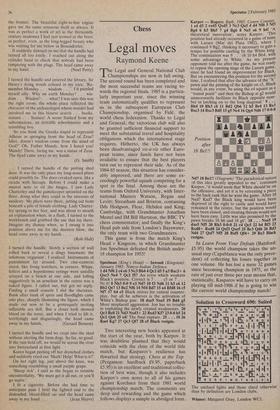Chess
Legal moves
Raymond Keene
The Legal and General National Club Championships are now in full swing. The second round has been completed and the most successful teams are racing to- wards the regional finals. 1985 is a particu- larly important year, since the winning team automatically qualifies to represent us in the subsequent European Club Championship, organised by Fide, the world chess federation. Thanks to Legal and General, the victorious club will also be granted sufficient financial support to meet the substantial travel and hospitality obligations which the international stage requires. Hitherto, the UK has always been disadvantaged vis-à-vis other Euro- pean teams, since funds have not been available to ensure that the best players turn out to represent their side. As of the 1984-85 season, this situation has consider- ably improved, and there are some ex- ceedingly powerful squads competing for a spot in the final. Among these are the teams from Oxford University, with Inter- national Masters Watson, Regan and Levitt; Streatham and Brixton, containing IMs Hodgson, Hear, Hebden and King; Cambridge, with Grandmaster Jonathan Mestel and IM Bill Hartston, the BBC TV chess commentator; and finally the King's Head pub side from London's Bayswater, the only team with two Grandmasters.
This game is from the match King's Head v Kingston, in which Grandmaster Jon Speelman defeated the British under- 18 champion for 1953!
Speelman (King's Head) — Inwood (Kingston): January 1985; Nimzo-Indian Defence.
1 d4 Nf6 2 c4 e6 3 Nc3 Bb4 4 Qc2 d5 5 a3 Bxc3+ 6 Qxc3 Ne4 7 Qc2 f5? An error which weakens Black's position. Correct is 7 . . . c5 or 7 . . . Nc 6! 8 Nh3 0-0 9 e3 Nd7 10 f3 Nd6 11 b3 c6 12 Bb2 Qe7 13 Be2 Nf6 14 Nf4 Bd7 15 a4 Rfd8 16 c5 N17 17 b4 e5 Black strives for central counter- play, but all he achieves is the activation of White's Bishop pair. 18 dxe5 Nxe5 19 Bd4 g5 More misplaced aggression. Jon has no trouble in exploiting the newly created weaknesses. 20 Qc3 Re8 21 Nd3 Nxd3+ 22 Bxd3 Kf7 230-0 h5 24 Qc2 Qe6 25 e4! The final rupture. 25 . . . f4 26 Rael Kg7 27 Qc3 Qf7 28 e5 Black resigns.
Two interesting new books appeared at the start of the year, both by Karpov. It was doubtless planned that they would coincide with the close of the world title match, but Kasparov's resilience has thwarted that strategy. Chess at the Top (Pergamon: hardback £9.95, paperback £5.95) is an excellent and traditional collec- tion of best wins, though it also includes Karpov's own notes to all of his games against Korchnoi from their 1981 world championship match. The comments are deep and rewarding and the game which follows displays a sample in abridged form. Karpov — Rogers: Bath. 1983: Centre Counter. 1 e4 d5 2 exd5 Qxd5 3 Nc3 Qa5 4 d4 Nf6 5 Nf3 Bg4 6 h3 Bh5 7 g4 Bg6 8 Ne5 e6 9 h4! theoretical innovation', notes Karpov. '1".Ms position had already occurred in a game of mine with Larsen (Mar del Plata 1982), where I continued 9 Bg2, thinking it necessary to gain a tempo for possible castling by the White king. The continuation was 9 . . . c6 10 h4 Bb4, with some advantage to White. As my present opponent told me after the game, he was ready to repeat the opening stage of the Larsen game, since he had found an improvement for Black. But on encountering this position for the second, time, I realised that after the advance of the "h pawn and the pinning of the knight on c3, Black would, in any event, be using the e4 square as a "transit point" and then the Bishop at g2 would unnecessarily facilitate its Black opposite num- ber in latching on to the long diagonal.' 9 • • • Bb4 10 Rh3 c6 11 Bd2 Qb6 12 h5 Be4 13 Re3 Bxc3 14 Bxc3 Bd5 15 g5 Ne4 16 Qg4 Nd6 170-0.0
Position
after 18 Bel!!
Nd7 18 Bel!! (Diagram) 'The paradoxical nature of this idea greatly appealed to me', continues Karpov, `it would seem that White should be on the offensive, and yet it is by retreating a piece to the back rank that he wins the game. After 18 Nxd7 Kxd7 the Black king would have been deprived of the right to castle and would have remained in the centre, but the position would have been closed, and creating threats would not have been easy. Little was also promised by the pawn breaks 18 h6 and 18 g6'. 18 . . . Nxe5 19 dxe5 Nf5 20 Rh3 0-0-0 21 c4 Qc5 22 b4 Bf3 23 Rxd8+ Rxd8 24 Qxf3 Qxe5 25 Bc3 Qd6 26 Bd3 Nd4 27 Qxf7 Nf5 28 Bxf5 Qf4+ 29 Re3 Black resigns.
In Learn From Your Defeats (Batsford: £5.95) the world champion takes the un- usual step (Capablanca was the only prece- dent) of collecting his losses together in one volume. He has lost a mere 32 games since becoming champion in 1975, so the rate of just over three per year means that, statistically, Kasparov will have to carry on playing till mid-1986 if he is going to win the current world championship match!










































 Previous page
Previous page